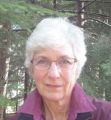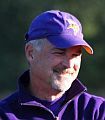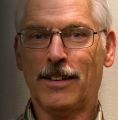HEALTHY WATERS PROGRAM FOR SALMON, WHALES, AND PEOPLE: “I think what is happening now is that we have lost touch with our watersheds,” stated Dr. Peter Ross of the Raincoast Conservation Foundation

“For Healthy Waters, we basically said, we would like to set up a community-oriented water pollution monitoring program for salmon, whales and people. Every conversation that I am having with watershed folks revolves around people wanting to know more so that they are empowered to do more. There is real value in the conversation and providing the data that helps them identify priorities and actions,” stated Peter Ross.
Erik Karlsen and the Streamside Protection Regulation

With release of the Water Sustainability Action Plan in 2004, a “design with nature” philosophy became an integral part of the branding for green infrastructure, rainwater management and water sustainability in BC. In 2015, the legendary Erik Karlsen created a matrix to explain how to integrate two foundational concepts that provide a path forward for designing with nature: Daniel Pauly’s Shifting Baseline Syndrome (1995); and Richard Horner and Chris May’s Road Map for Protecting Stream System Integrity (1996).
SHELLY CREEK PARK IN PARKSVILLE IS A LIVING LABATORY: “The City of Parksville’s decision in the 1990s to create a greenway along Shelly Creek resulted in an ecological legacy for fish and residents,” Peter Law, Past-President of the Mid Vancouver Island Habitat Enhancement Society (MVIHES)

Peter Law has put his time and energy into Shelly Creek, as do many other stream stewards in their watersheds around BC, such that Shelly Creek has become a “living laboratory” for the local Parksville community to enjoy. “Enhanced riparian greenways like Shelly Creek Park allow fish to survive in natural conditions without encroachment issues. That 1990s decision to create an enhanced linear park showed great foresight. The proof of the pudding is that it saved the resident Cutthroat trout population during the heat dome and extreme drought of 2021,” stated Peter Law.
BC’s PATH TO FOOD SECURITY IS THRU WATER SECURITY: “When we think of all the changes in thinking that we have gone through in the last 50 years, the Land Commission Act really is a testament to the incredible foresight demonstrated in 1973,” stated Joan Sawicki, former MLA

“At a time when most other jurisdictions continue to lose their food lands, BC’s ALR remains the most successful agricultural land preservation program in North America. With food security now becoming a top-of-mind public issue, thanks to the foresight demonstrated in 1973 we still have “the land” – and I submit we would not still have the option for viable agricultural sectors in high growth areas like the Lower Mainland or the Okanagan without the ALR. The ALR has been doing exactly what it was designed to do,” stated Joan Sawicki.
Looking at green roofs through a water balance lens: “How much better does a ‘blue-green connected’ roof perform?”

“The light bulbs started going off and I started doing some research. There was not much information. So, it felt like an ingenious idea except when I went to my professor to discuss it. How do you get the water back up, he asked. We do not want to pump because that uses energy. Then I started doing more research. I was thinking in terms of something like sponge towels, that acts like capillary irrigation. They transfer water from more wet moist to less wet moist. In the summer, these green roofs would not need irrigation water and we could use some of the water we have stored from each rainfall,” stated Harvy Takhar.
Local governments invest in youth at Vancouver Island University as part of 3-year transition strategy to embed EAP, the Ecological Accounting Process

“There are lots of partnerships that exist for selfish reasons. But the EAP Partnership is selfless; and from all angles. It is a leap of faith for member local governments. Partnership for Water Sustainability commitment to passing the baton is unwavering. Vancouver Island University is all-in because EAP is an idea that can change the game. And students are excited to contribute to the change. In a phrase, the framework for the EAP Partnership is foundational. It is also outcome-oriented,” stated Graham Sakaki.
ROAD MAP FOR STREAM SYSTEM INTEGRITY: The enduring legacy of Richard Horner and Chris May is that they applied systems thinking, investigated whole systems in place, identified four limiting factors, and definitively established their order-of-priority

In the 1990s, Puget Sound research correlated land use changes with impacts on stream system condition. “Timing is everything. You learn that as you go through life. It was good timing because everyone was crying out, what is wrong and what can we do. In the 1990s, we were able to come up with some pretty good data and our conclusions are standing the test of time. Looking back, everything came together at the same time. Rich Horner and my work pointed out the problems. And the early green infrastructure work pointed to potential solutions,” stated Chis May.
Communities need annual budgets to tackle the Riparian Deficit along streams

The requirement that local governments have an Asset Management Plan addresses the disconnect between land use oversight and direct responsibility for maintenance and management of stream corridor condition. “The oversight question is one that we are addressing with EAP. Local governments have real data to quantify the financial value of streams as physical assets. This metric allows them to put streams into the basket of local government asset management responsibilities,” stated Tim Pringle.
Build bridges of understanding, pass the baton!

“A Partnership strength is the real-world experience we bring because of our multiple initiatives under Living Water Smart Actions. Under that vision, various building blocks processes have evolved over the decades. The Watershed Security Strategy and Fund, an initiative of the current provincial government, is the obvious mechanism to revisit, understand, learn from, and leverage past successes in the building blocks continuum. We have tools to help do the job. We can achieve better stewardship of BC’s water resources for present and future generations,” stated Ted van der Gulik.
Town of Comox – beacon of inspiration for water balance approach to land development

“I am proud of what the Town has accomplished over the past decade. It took hard work though. Now that the Northeast Comox rainwater management plan is in place, water balance modeling is a requirement, and supporting bylaws help us regulate what developers must do on the ground. All in all, it has been such a huge step for the Town to get to where we have arrived at,” stated Shelley Ashfield. The Town had to re-invent what have been accepted development practices. Historical failure by designers to apply the fundamentals of a water balance approach perpetuates degrading of urban streams.

